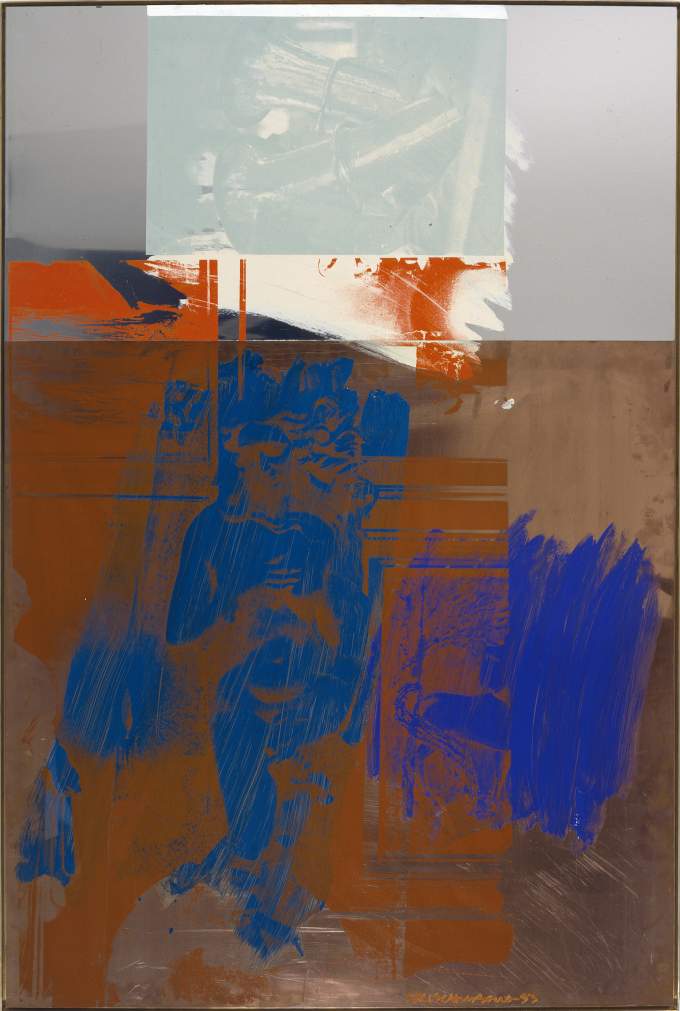
Aqua Fanfare (Urban Bourbon), 1993, acrylic on copper and mirrored aluminum, 72 13/16 x 48 13/16 inches (184.9 x 124 cm).
Robert Rauschenberg: Works on Metal
I like seeing people using materials that one’s not accustomed to seeing in art. That has a particular value. New materials have fresh associations, physical properties and qualities that have built into them the possibility of forcing you or helping you do something else.
—Robert Rauschenberg
In collaboration with the Robert Rauschenberg Foundation, Gagosian Beverly Hills is pleased to announce an exhibition of Robert Rauschenberg’s works on metal of the 1980s and 1990s. This will be the first major presentation of his work on the West Coast since MOCA’s acclaimed traveling exhibition of the Combines in 2006.
Rauschenberg’s protean outlook ushered in a new era of postwar American art in the wake of Abstract Expressionism with a free and experimental approach that drew inspiration from conceptual, materialist, and gestural precedents. His inventive use of discarded materials and appropriated images eviscerated distinctions between medium and genre, abstraction and representation, while his “flatbed picture plane,” which absorbed found objects into the realm of paintings, forever changed the relationship between artwork and viewer.
“Works on Metal” traces Rauschenberg’s obsession, beginning in the mid-1980s, with the potential of metal. Exchanging canvas for flat sheets of metal mounted directly to the wall, he worked in consequent series using aluminum, brass, copper, and bronze, harnessing the natural hues and reflections of each. He then juxtaposed their intrinsic qualities with secondary processes, from the application of acrylic and enamel paints and silkscreened photographic images to his fine-tuning of chemical reactions and manipulation of industrial scrap and refuse.
For his prescient project of global diplomacy known as ROCI (Rauschenberg Overseas Culture Interchange, 1984–91), Rauschenberg worked and exhibited in eleven countries including Chile and Cuba, silkscreening photographic images taken during his extensive travels onto huge sheets of copper and stainless steel. Drawing upon this bountiful image bank, his ongoing investigation of painting on metal would prove to be one of the most inventive periods of his career, taking on ever new inflections as he traveled to Mexico, Germany, Tibet, the former U.S.S.R., Venezuela, and other locations. In the Urban Bourbon series (1988–96), reflective depths overlap with fragmented photography and gestural brushwork; in the Borealis paintings (1988–92), chemicals and ammonium salts were applied to brass, copper, and bronze sheets to achieve corrosive effects; in the steely Night Shades (1991), acids were used to rapidly tarnish the mirrored and brushed aluminum surfaces.
Parallel to his works on flat metal surfaces, Rauschenberg collected discarded automotive parts, gas station signs, and other scrap materials, which he manipulated into both freestanding and wall-mounted sculptures; the so-called Gluts (1986–89/1991–94) echoed the Combines in their reconfiguration of found objects. Rauschenberg referred to the Gluts, which he continued to produce after the seven-year ROCI. tour, as “souvenirs without nostalgia;” he aimed to create art that was “as fresh, strange and unpredictable as what’s going on around you.” In the conceptual and material breadth of the metal works, Rauschenberg fulfilled the partial relinquishing of authorship, allowing art to integrate with the mess of life.
The exhibition is accompanied by a fully illustrated catalogue with an essay by Joachim Pissarro.
